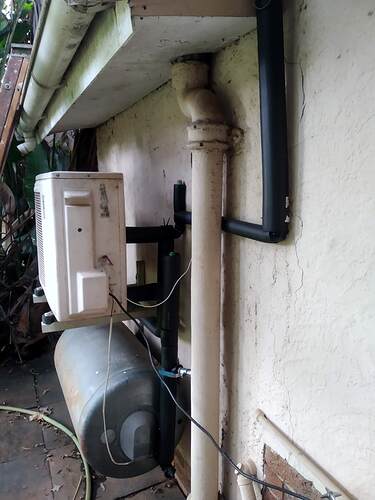I bought a ITS heatpump secondhand from someone that emigrated. It started with:
I will mount it on the wall and save a plumber some time.
Then I realised my current geyser is on its last legs, water was dripping from it (dates back 1996)
So I Installed another geyser onto the same wall below the heatpump.
Then I thought to myself that copper plumbing looks very simple (and yes it is)
So I started researching the different pieces, Y-Strainer, Vacuum breakers, ball valves and and brass fittings to connect the galvanised to copper. I designed something which can be removed in pieces with compression fittings to connect them. 5 pieces in total. IT took me 3 full days building and fitting the design, and another day to cover all the pipes with R1 Insulation. I just hate it when there is air in the system so the design has 3 vacuum breakers.
I did not get the NTC with the heatpump so I plugged in the NTC that came with my geyserwise and calculated the error, and adjusted the settings to account for the error.
My heatpump has been in operation for about 3 months now and works perfectly.
Still have to neaten the wires and install an isolator switch.
All in all I spent about a week. I spent about R4-5K in copper pipes, fittings, tools, blow torch etc.
Just the insulation alone was more than R800.
My friends think I am crazy, just pay a plumber they will be done in 3-4 hours.
If I take what I earn and calculate the cost it might be one of the most expensive installs.
Reading this forum I am starting to feel better about myself, there are other people like me… Saw on another thread people are installing their own aircons. Should I be joining a support group to help me with the “buy all the tools and do it yourself” mentality?
The whole… have to service the heatpump nonsense I simply do not buy. Do you have to service your fridge every year? Flush the dust off the heat exchanger. The refrigerant is a closed loop and should never loose any gas. If it loses gas there is a leak and which requires an expert with the right equipment to detect and repair.
Next steps: Automate the heatpump to automatically run during the warmest part of the day. Once my solar is installed I will be running the heatpump from solar power only.
I am open to questions if you want to follow this crazy route youself.
Edit: Added some pictures


